Study of Tower Clearance Safety Protection during Extreme Gust Based on Wind Turbine Monitoring Data
Abstract
:1. Introduction
2. Method
2.1. Gust Identification Method
- is the moment inertia of the rotor (kg·m2);
- is the rotor’s speed (rad/s);
- is the aerodynamic torque (N.m/rad);
- is the torsional rigidity (N.m/rad);
- is the torsion angle of the mainshaft (rad);
- is the torsion damper (kg·m2/rad·s);
- is the viscous friction force at the rotor side (kg·m2/rad·s);
- is the gearbox’s transmission ratio;
- is the generator’s speed (rad/s);
- is the generator’s electromagnetic torque (N.m);
- is the moment inertia of the high-speed shaft (kg·m2);
- is the efficiency of the wind turbine transmission system;
- is the viscous friction force of the generator side (kg·m2/rad·s).
2.2. Tower Clearance Safety Protection Strategy
3. Simulation
3.1. Wind Turbine and Extreme Gust Model
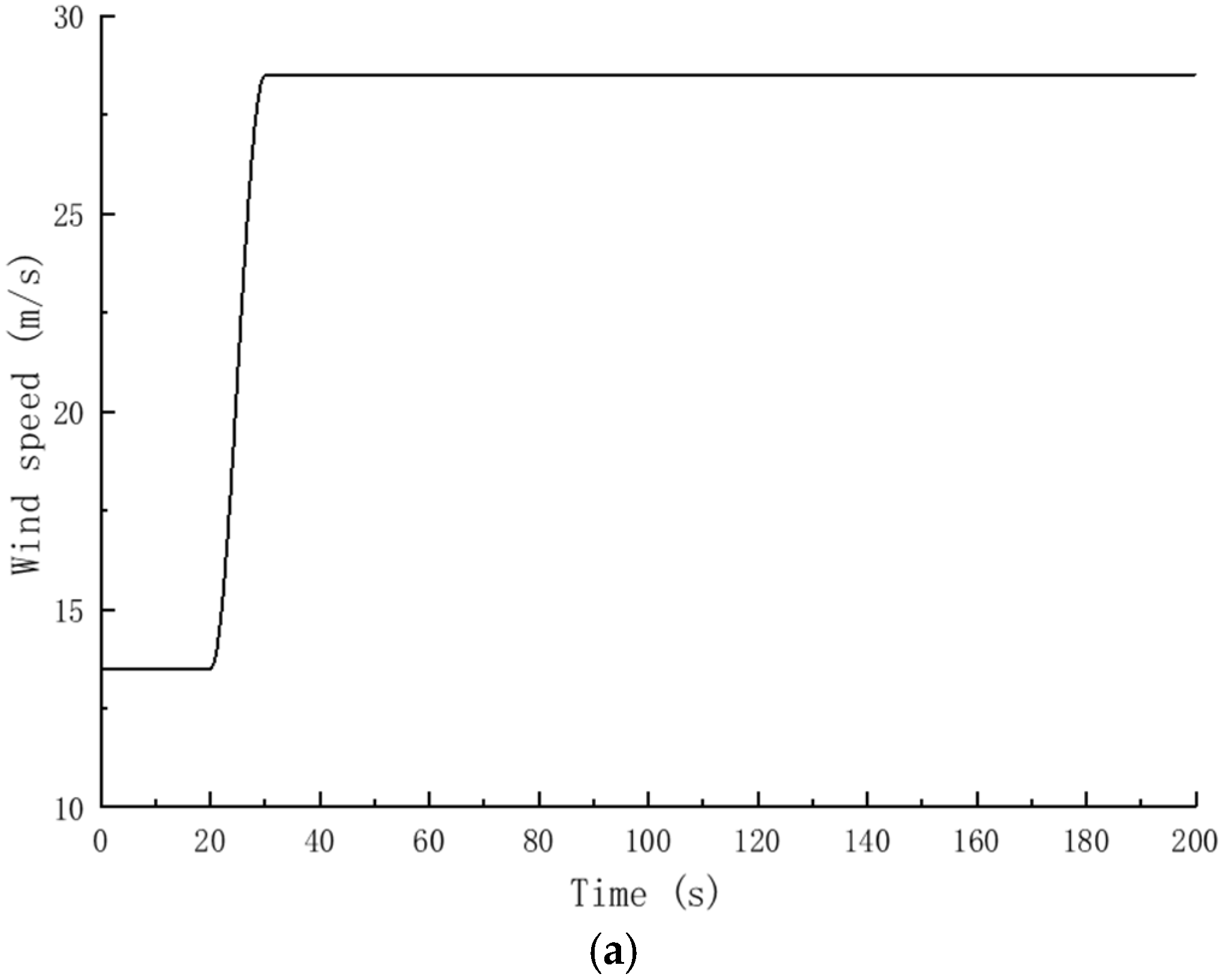

3.2. Simulation Results Analysis
4. Conclusions
- (a)
- The generator speed of the wind turbine increases rapidly during extreme gusts, which can trigger overspeed protection and lead to an emergency shutdown. The coupling effect of the shutdown and gust makes the wind turbine produce strong dynamic responses.
- (b)
- After adopting the TCSP strategy, the pitch rate under gust condition increased by 1.5 times; this causes the wind turbine to additionally increase the pitch angle at the same time and avoids an overspeed of the generator.
- (c)
- After adopting the TCSP strategy, blade tip deformation and the load on the top of the tower are reduced by 19.9% and 52.5%, respectively. This means that the TCSP strategy not only protects the wind turbine’s safety but also reduces costs.
Author Contributions
Funding
Conflicts of Interest
References
- Enevoldsen, P.; Xydis, G. Examining the trends of 35 years growth of key wind turbine components. Energy Sustain. Dev. 2019, 50, 18–26. [Google Scholar] [CrossRef]
- McKenna, R.; Pfenninger, S.; Heinrichs, H.; Schmidt, J.; Staffell, I.; Bauer, C.; Gruber, K.; Hahmann, A.N.; Jansen, M.; Klingler, M.; et al. High-resolution large-scale onshore wind energy assessments: A review of potential definitions, methodologies and future research needs. Renew. Energy 2022, 182, 659–684. [Google Scholar] [CrossRef]
- Cai, X.; Wang, Y.; Xu, B.; Feng, J. Performance and effect of load mitigation of a trailing-edge flap in a large-scale offshore wind turbine. J. Mar. Sci. Eng. 2020, 8, 72. [Google Scholar] [CrossRef] [Green Version]
- Hu, A.; Bu, A.; Vvs, B. Structural integrity analysis and damage assessment of a long composite wind turbine blade under extreme loading. Compos. Struct. 2020, 246, 112426. [Google Scholar]
- Zhu, X.; Chen, J.; Shen, X.; Du, Z. Impact of blade flexibility on wind turbine loads and pitch settings. J. Sol. Energy Eng. 2018, 141, 041002. [Google Scholar] [CrossRef]
- IEC 61400-1:2019; Systems—Part 1: Design Requirements. International Electrotechnical Commission: Geneva, Switzerland, 2019.
- Germanischer Lloyd. Guideline for the Certification of Wind Turbines; Germanischer Lloyd: Hamburg, Germany, 2010. [Google Scholar]
- Han, B.; Zhou, L. Research on individual pitch control below rated wind speed. IEEE Trans. Electr. Electron. Eng. 2017, 12, 38–44. [Google Scholar] [CrossRef]
- Bortolotti, P.; Bottasso, C.L.; Croce, A.; Sartori, L. Integration of multiple passive load mitigation technologies by automated design optimization—The case study of a medium-size onshore wind turbine. Wind Energy 2019, 22, 65–79. [Google Scholar] [CrossRef] [Green Version]
- Bernhammer, L.O.; Kuik, G.V.; Breuker, R. Fatigue and extreme load reduction of wind turbine components using smart rotors. J. Wind Eng. Ind. Aerodyn. 2016, 154, 84–95. [Google Scholar] [CrossRef]
- Lackner, M.A.; Kuik, G.V. The performance of wind turbine smart rotor control approaches during extreme loads. J. Sol. Energy Eng. 2010, 132, 937. [Google Scholar] [CrossRef]
- Zhang, M.M.; Tan, B.; Xu, J.Z. Smart load control on large-scale wind turbine blades due to extreme coherent gust with direction change. J. Renew. Sustain. Energy 2015, 7, 023110. [Google Scholar] [CrossRef]
- Meng, F.; Wenske, J.; Gambier, A. Wind turbine loads reduction using feedforward feedback collective pitch control based on the estimated effective wind speed. In Proceedings of the American Control Conference, Boston, MA, USA, 6–8 July 2016. [Google Scholar]
- Zhuang, Z.; Liu, X.; Chen, X. Estimation method of turbulent wind speed based on lidar pulse characteristics. Infrared Laser Eng. 2018, 47, 1106001. [Google Scholar] [CrossRef]
- Cortina, G.; Calaf, M. Turbulence upstream of wind turbines: A large-eddy simulation approach to investigate the use of wind lidars. Renew. Energy 2017, 105, 354–365. [Google Scholar] [CrossRef]
- Kumer, V.M.; Reuder, J.; Dorninger, M.; Zauner, R.; Grubišić, V. Turbulent kinetic energy estimates from profiling wind lidar measurements and their potential for wind energy applications. Renew. Energy 2016, 99, 898–910. [Google Scholar] [CrossRef] [Green Version]
- Pace, A.; Johnson, K.; Wright, A. Preventing wind turbine overspeed in highly turbulent wind events using disturbance accommodating control and light detection and ranging. Wind Energy 2015, 18, 351–368. [Google Scholar] [CrossRef]
- Haizmann, F.; Schlipf, D.; Cheng, P.W. Lidar-assisted extreme load reduction by multi-variable protective derating. J. Phys. Conf. Ser. 2018, 1037, 032025. [Google Scholar] [CrossRef]
- Rodrigo, J.S.; Gancarski, P.; Arroyo, R.C.; Moriarty, P.; Chuchfield, M.; Naughton, J.W.; Hansen, K.S.; Machefaux, E.; Koblitz, T.; Maguire, E.; et al. Iea-task 31 wakebench: Towards a protocol for wind farm flow model evaluation. Part 1: Flow-over-terrain models. J. Phys. Conf. Ser. 2014, 524, 012105. [Google Scholar] [CrossRef] [Green Version]
- Dickler, S.; Wiens, M.; Thonnissen, F.; Jassmann, U.; Abel, D. Requirements on super-short-term wind speed predictions for model predictive wind turbine control. In Proceedings of the 2019 18th European Control Conference (ECC), Naples, Italy, 25–28 June 2019. [Google Scholar]
- Lio, A.; Meng, F. Effective wind speed estimation for wind turbines in down-regulation. J. Phys. Conf. Ser. 2020, 1452, 012008. [Google Scholar] [CrossRef] [Green Version]
- Soltani, M.N.; Knudsen, T.; Svenstrup, M.; Wisniewski, R. Estimation of rotor effective wind speed: A comparison. IEEE Trans. Control Syst. Technol. 2013, 21, 1155–1167. [Google Scholar] [CrossRef]
- Gocmen, T.; Giebel, G. Estimation of turbulence intensity using rotor effective wind speed in lillgrund and horns rev-i offshore wind farms. Renew. Energy 2016, 99, 524–532. [Google Scholar] [CrossRef] [Green Version]
- Kanev, S.; Engelen, T.V. Wind turbine extreme gust control. Wind Energy 2010, 13, 18–35. [Google Scholar] [CrossRef]
- Wiens, M.; Meyer, T.; Wenske, J. Exploiting bend-twist coupling in wind turbine control for load reduction. IFAC-PapersOnLine 2020, 53, 12139–12144. [Google Scholar] [CrossRef]
- Kumar, D.; Chatterjee, K. A review of conventional and advanced MPPT algorithms for wind energy systems. Renew. Sustain. Energy Rev. 2016, 55, 957–970. [Google Scholar] [CrossRef]
- Elsisi, M.; Tran, M.Q.; Mahmoud, K.; Lehtonen, M.; Darwish, M. Robust design of ANFIS based blade pitch controller for wind energy conversion systems against wind speed fluctuations. IEEE Access 2021, 9, 37894–37904. [Google Scholar] [CrossRef]
- Bossanyi, E.A. The design of closed loop controllers for wind turbines. Wind Energy 2000, 3, 149–163. [Google Scholar] [CrossRef]
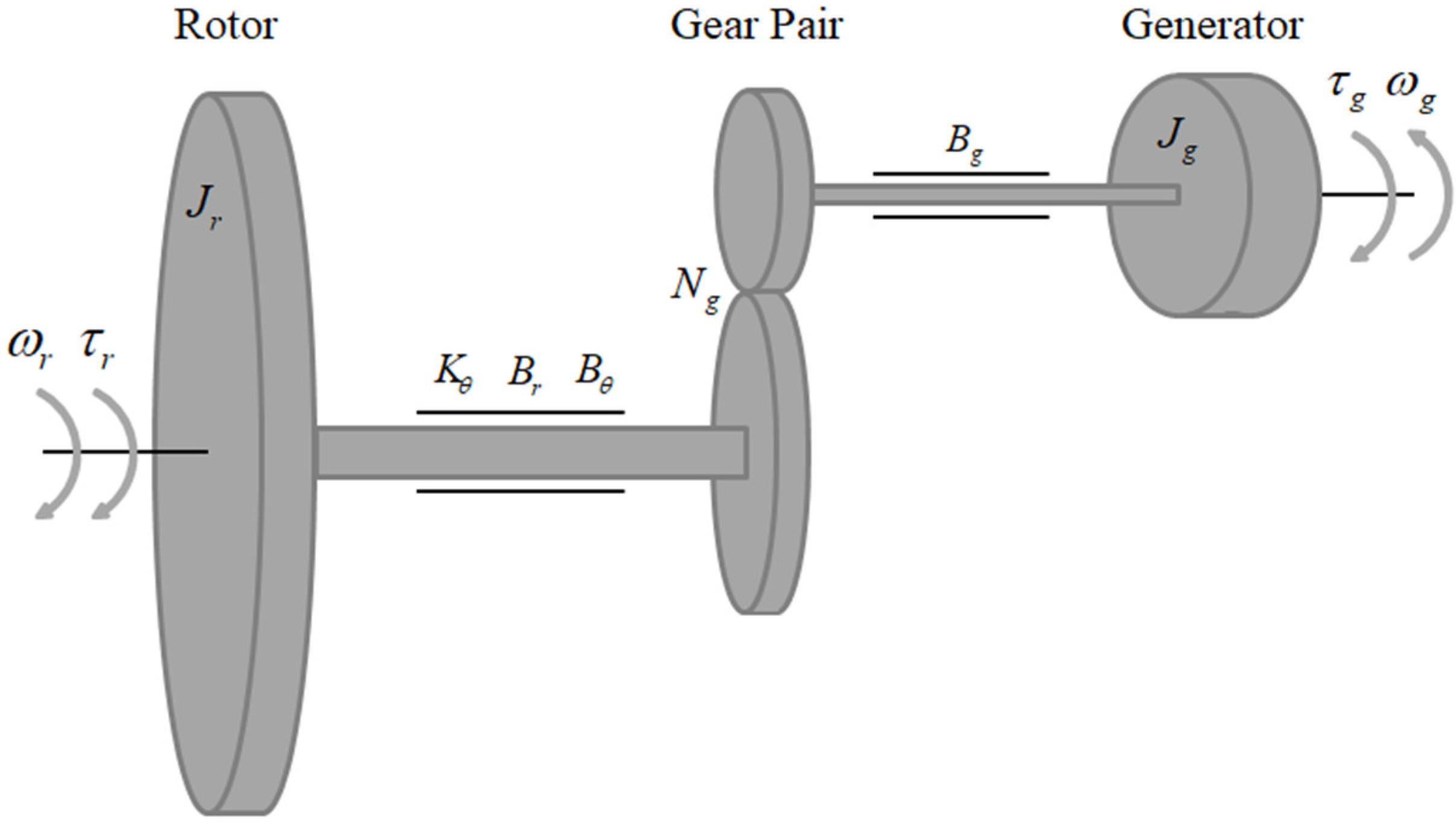
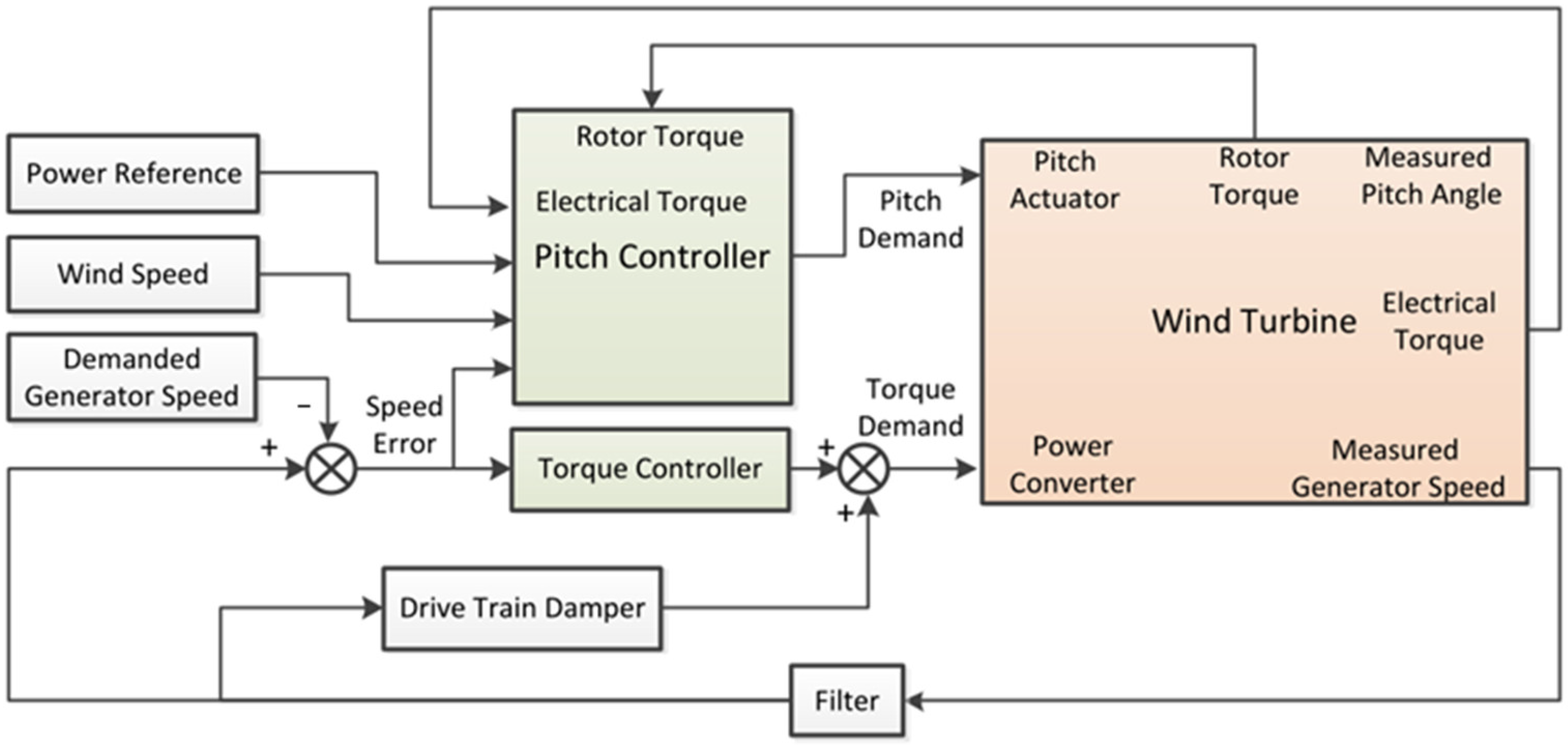

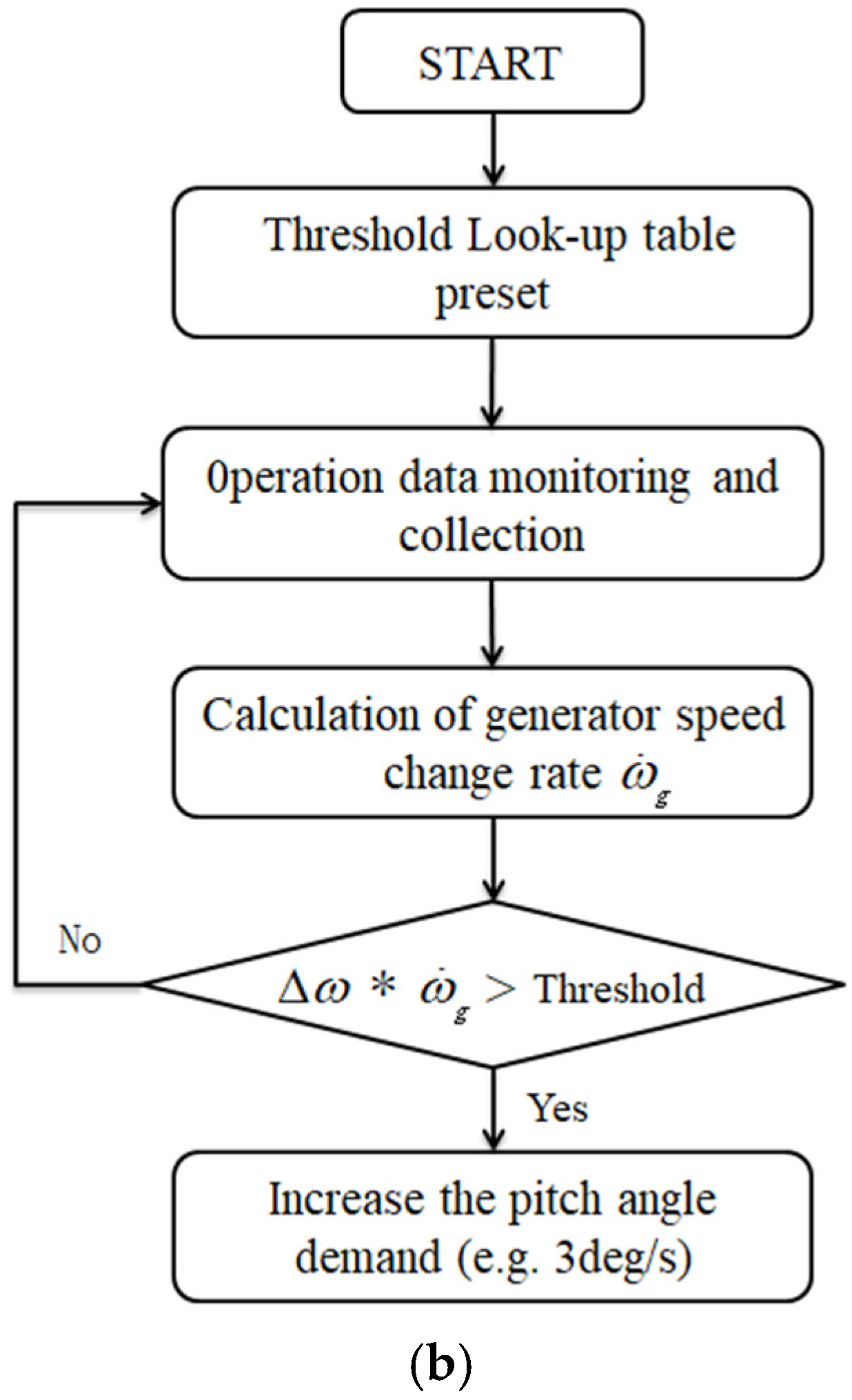


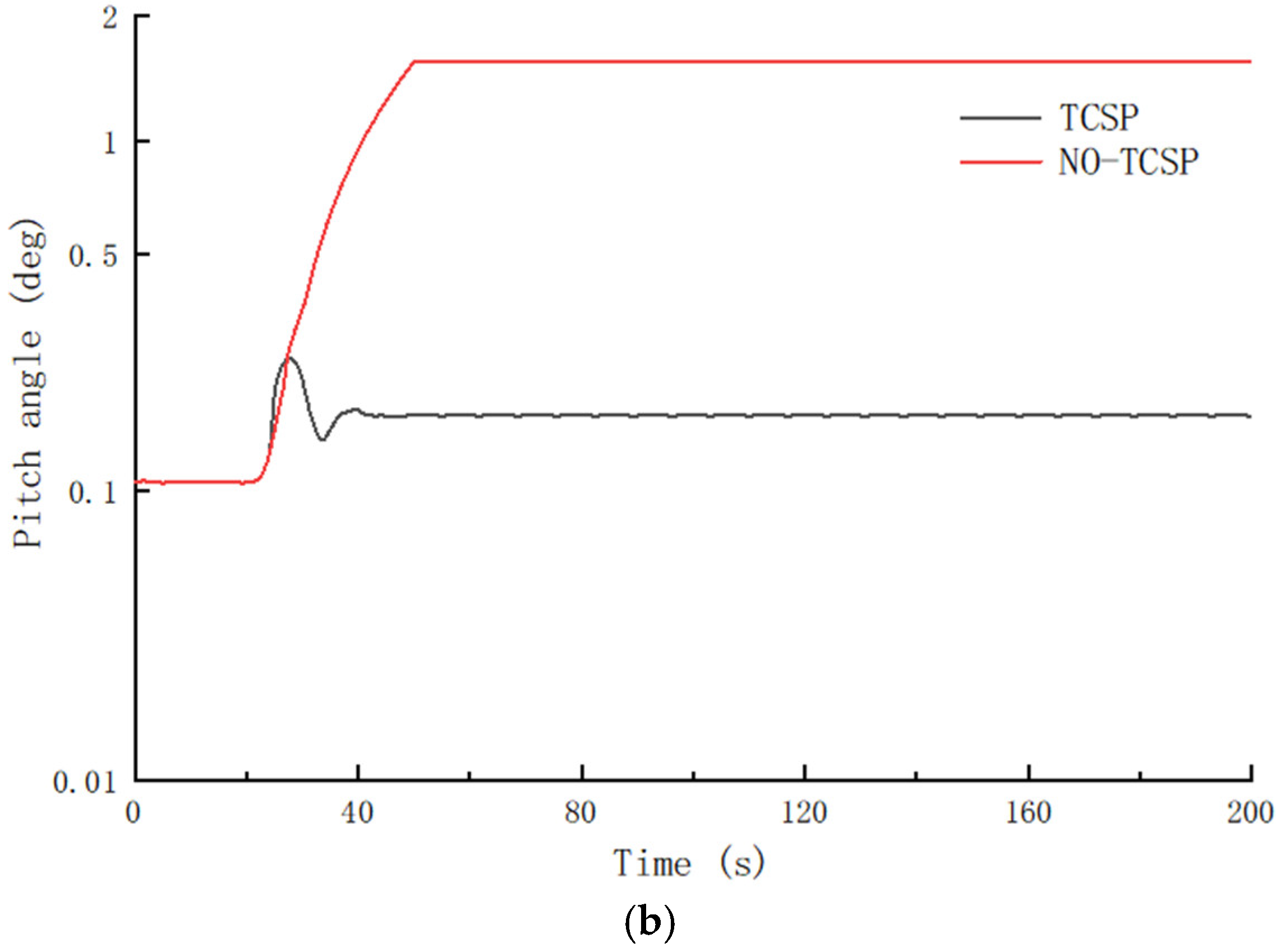


| Wind Turbine Type | CT 5.0-184 |
|---|---|
| Rotor diameter (m) | 184 |
| Rated power (MW) | 5 |
| Design wind zone | IEC IIIB |
| Cut-in wind speed (m/s) | 2.5 |
| Cut-out wind speed (m/s) | 20 |
| Rotor speed (r/min) | 5~9.8 |
| Blade tip Pre-bend (m) | 3.95 |
| Rotor cone angle (deg) | −5 |
| Rotor tilt angle (deg) | 7 |
| Tower height (m) | 110 |
| Pitch Angle (rad) | 0 | 0.087266 | 0.261799 | 0.349066 | 0.610865 | 0.610865 |
| Threshold | 10 | 15 | 45 | 60 | 60 | 60 |
Publisher’s Note: MDPI stays neutral with regard to jurisdictional claims in published maps and institutional affiliations. |
© 2022 by the authors. Licensee MDPI, Basel, Switzerland. This article is an open access article distributed under the terms and conditions of the Creative Commons Attribution (CC BY) license (https://creativecommons.org/licenses/by/4.0/).
Share and Cite
Wang, Y.; Cai, X.; Lin, S.; Xu, B.; Zhang, Y.; Bian, S. Study of Tower Clearance Safety Protection during Extreme Gust Based on Wind Turbine Monitoring Data. Energies 2022, 15, 4400. https://doi.org/10.3390/en15124400
Wang Y, Cai X, Lin S, Xu B, Zhang Y, Bian S. Study of Tower Clearance Safety Protection during Extreme Gust Based on Wind Turbine Monitoring Data. Energies. 2022; 15(12):4400. https://doi.org/10.3390/en15124400
Chicago/Turabian StyleWang, Yazhou, Xin Cai, Shifa Lin, Bofeng Xu, Yuan Zhang, and Saixian Bian. 2022. "Study of Tower Clearance Safety Protection during Extreme Gust Based on Wind Turbine Monitoring Data" Energies 15, no. 12: 4400. https://doi.org/10.3390/en15124400






